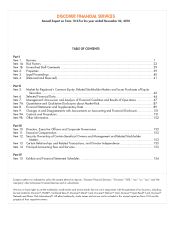Discover 2010 Annual Report Download - page 21
Download and view the complete annual report
Please find page 21 of the 2010 Discover annual report below. You can navigate through the pages in the report by either clicking on the pages listed below, or by using the keyword search tool below to find specific information within the annual report.Seasonality
In our credit card business, we experience fluctuations in transaction volumes and the level of loan receivables as a
result of higher seasonal consumer spending and payment patterns around the winter holidays, summer vacations and
back-to-school periods. In our student loan business, our loan disbursements peak at the beginning of a school’s
academic semester or quarter. Although there is a seasonal impact to transaction volumes and the level of student and
credit card loan receivables, seasonal trends have not caused significant fluctuations in our results of operations or credit
quality metrics between quarterly and annual periods.
Revenues in our Diners Club business are generally higher in the first half of the year as a result of Diners Club’s tiered
pricing system where licensees qualify for lower royalty rate tiers as cumulative volume grows during the course of the
year.
Competition
We compete with other credit card issuers and networks on the basis of a number of factors, including brand,
reputation, reward programs, customer service, merchant acceptance, product offerings, incentives, and pricing. As a
credit card issuer, we compete for accounts and utilization with cards issued by other financial institutions (including
American Express, Bank of America, Capital One, JPMorgan Chase and Citigroup) and, to a lesser extent, businesses
that issue their own private label cards or otherwise extend credit to their customers. In comparison to our largest credit
card competitors, our strengths have included cash rewards, conservative portfolio management and strong customer
service. As a student loan issuer, we compete for customers with Sallie Mae, Wells Fargo and JPMorgan Chase, as well
as other financial institutions that offer student loans, on the basis of customer service, pricing and rewards. As a personal
loan issuer, we compete for customers primarily with Bank of America, JPMorgan Chase, Capital One and Wells Fargo,
generally on the basis of the loan product’s terms.
Although our student and personal loan receivables have increased as a percentage of total loans, our credit card
receivables continue to represent a substantial portion of our receivables. The credit card business is highly competitive.
Some of our competitors offer a wider variety of loan products than we do, including automobile and home loans, which
may position them better among customers who prefer to use a single financial institution to meet all of their financial
needs. Some of our competitors enjoy lower cost of funds and greater capital resources than we do, and are therefore
able to invest more in initiatives to attract and retain customers, such as advertising, targeted marketing, account
acquisitions and pricing competition in interest rates, annual fees, reward programs and low-priced balance transfer
programs.
Because most domestically issued credit cards, other than those issued on the American Express network, are issued on
the Visa and MasterCard networks, most other card issuers benefit from the dominant market share of Visa and
MasterCard. The former exclusionary rules of Visa and MasterCard limited our ability to attract merchants and credit and
debit card issuers, contributing to Discover not being as widely accepted in the U.S. as Visa and MasterCard. Merchant
acceptance of the Discover card, however, has continued to increase and we are making investments to further grow
acceptance both domestically and internationally.
In our payment services business, we compete with other networks for volume and to attract third-party issuers to issue
credit, debit and prepaid cards on the Discover, PULSE and Diners Club networks. We generally compete on the basis of
customization of services and various pricing strategies, including incentives and rebates. The Diners Club and Discover
networks’ primary competitors are Visa, MasterCard and American Express, and PULSE’s competitors include Visa’s
Interlink, STAR, and MasterCard’s Maestro. American Express is a particularly strong competitor to Diners Club as both
cards significantly target international business travelers.
In our direct-to-consumer deposits business, we have acquisition and servicing capabilities similar to other direct
competitors, including Ally Financial, American Express, Capital One Direct, HSBC Direct and ING Direct. We also
compete with traditional banks and credit unions that source deposits through branch locations. We seek to differentiate
our deposits product offerings on the basis of brand reputation, convenience, customer service, and value.
For discussion of the risks we face with respect to competition, see “Risk Factors.”
-10-
























